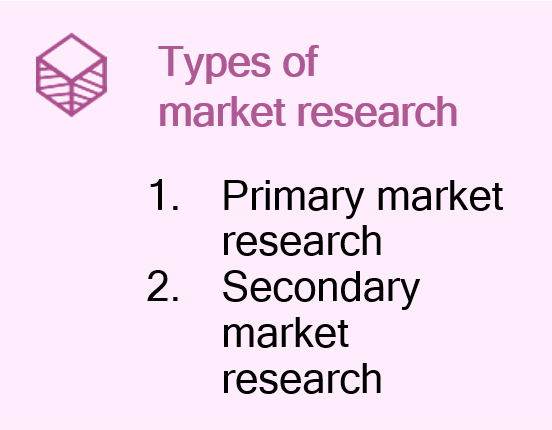 Market Research Market Research
Definition of market research Click to read Click to read
Market research is the process of determining if a new good or service is marketable via interviews with potential customers. Organizations or corporations may use this technique to identify their target market, gather and record comments, and make wise decisions.
How?
Market research can be carried out in-house by businesses or organizations, or it can be outsourced out to companies with experience in the field. |
|
Why?
The main goal of market research is to comprehend or evaluate the market for a certain good or service and to predict how the target market will respond to it. |
| |
|
 |
Three key objectives of market research Click to read Click to read
| |
Administrative
Facilitate a company's or business's growth by effective planning, coordination, and management of both people and material resources, and so meet all specific market demands at the appropriate moment.
|
|
Social
Provide a necessary good or service that satisfies the customer's particular demands. When a consumer consumes a product or service, it should do so in a way that is in accordance with their needs and preferences.
|
|
Economic
Determine the economic likelihood that a business will succeed or fail when it enters a new market or otherwise introduces new goods or services. This will give all future decisions confidence.
|
| |
|
|
 |
Typologies of Market Research  Click to read Click to read
|
Primary Market Research
Primary market research is the procedure through which companies or organizations speak with the final customers or hire a third party to conduct pertinent studies to gather data. The information gathered may be quantitative or qualitative (non-numerical) (numerical or statistical data).
|
|
Secondary Market Research
Secondary research makes use of data that has been compiled by other sources such as governmental bodies, the press, chambers of business, etc. Publications of this material include books, newspapers, periodicals, corporate websites, free government agencies, and so on.
|
| |
 |
Summing up
Summing up Click to read Click to read
| Summing up |
 |
Market Research
Determining if a new good or service is marketable via interviews with potential customers. |
|
 |
Objectives of market research
1. Administrative
2. Social
3. Economic
|
|
 |
Types of market research
1. Primary market research
2. Secondary market research
|
 Market Analysis Market Analysis
Definition of Market Analysis Click to read Click to read
Market analysis is a large part of market research and an important component of a business plan. It provides information on markets, consumers, rivals, and other market factors.
How?
Information is collected and evaluated from suppliers and buyers in order to make purchase or sales decisions. |
|
Why?
A comprehensive market analysis forms the basis of the development of a marketing strategy and concrete marketing measures. |
Differences between market analysis and market research Click to read Click to read
| Market Analysis |
Market Research |
- Market Analysis is a much larger exercise that may encompass your own firm, rivals, the business backdrop, and customers
|
- Market research, on the other hand, is typically quite targeted in nature, with the goal of testing a hypothesis or getting to know the (identified) customers
|
- Market analysis is broad in scope, accumulating vast volumes of cold-hard data and numbers
|
- Market research is limited in time, audience, emotions, and views, and is reliant on human interpretation.
|
- Market analysis gathers large and highly complex clusters of data
|
- Market research collects only the data points required to answer certain research issue(s).
|
- Market analysis gives longer-term insights
|
- Market research data are only useful for a few years.
|
- Market analysis provides just quantitative data
|
- Market research can provide both qualitative and quantitative data
|
Typologies of Market Analysis Click to read Click to read
|
Industry Studies
These reports are thorough and broad in coverage, providing a comprehensive view of an industry: not only include top-line growth rates, but also estimates based on market segmentation and market share by top items and rivals.
They take into consideration disruptions, legislative upheavals, consumer trends, and other variables that are projected to have an influence on an industry.
|
Niche Studies
Niche reports provide in-depth analysis of rapidly emerging or revolutionary new product sectors that are anticipated to have a big influence on their respective industries in the near and/or long term.
|
Focus Studies
These are brief market research reports designed to give rapid insights into a wide range of products and services.
The papers focus on market size, segmentation, and forecasting, as well as identifying major suppliers, against the backdrop of key quantitative and qualitative trends.
|
Customer research
When off-the-shelf research is insufficient to fulfil a company's particular demands, clients can commission custom research reports that are tailored to the company's exact specifications.
These studies give better insights into strategic planning, new product development, global market growth, mergers and acquisitions, competition intelligence, and much more.
|
| |
 |
Summing up Click to read Click to read
| Summing up |
 |
Market Analysis
Provides information on markets, consumers, rivals, and other factors. |
|
|
|
|
 |
Types of market analysis
1. Comprehensive industry studies
2. Niche/hot topic studies
3. Focus studies
4. Custom research
|
 A framework for MRKT Research & Analysis A framework for MRKT Research & Analysis
The Six Dimension of National Culture Click to read Click to read
Hofstede’s Cultural Dimensions Theory is a framework used to understand the differences in culture across countries and to discern the ways that business is done across different cultures. In other words, the framework is used to distinguish between different national cultures, the dimensions of culture, and assess their impact on a business setting.
|
 |
|
Hofstede identified six categories that define culture:
- Power Distance Index
- Collectivism vs. Individualism
- Uncertainty Avoidance Index
- Femininity vs. Masculinity
- Short-Term vs. Long-Term Orientation
- Restraint vs. Indulgence
|
| |
A deep-dive into Hofstede’s Model Click to read Click to read
|
Power Distance Index (PDI)
This dimension expresses the degree to which the less powerful members of a society accept and expect that power is distributed unequally. The fundamental issue here is how a society handles inequalities among people.
|
Individualism VS Collectivism (IDV)
The high side of this dimension, called Individualism, can be defined as a preference for a loosely-knit social framework in which individuals are expected to take care of only themselves and their immediate families.
|
Masculinity VS Femininity (MAS)
The Masculinity side of this dimension represents a preference in society for achievement, heroism, assertiveness, and material rewards for success. Society at large is more competitive. Its opposite, Femininity, stands for a preference for cooperation, modesty, caring for the weak and quality of life. Society at large is more consensus-oriented.
|
|
Uncertainty Avoidance Index (UAI)
The Uncertainty Avoidance dimension expresses the degree to which the members of a society feel uncomfortable with uncertainty and ambiguity. The fundamental issue here is how a society deals with the fact that the future can never be known: should we try to control the future or just let it happen?
|
Long term VS short Term orientation (LTO)
Every society has to maintain some links with its own past while dealing with the challenges of the present and the future. Societies prioritize these two existential goals differently.
|
Indulgence VS Restraint (IVR)
Every society has to maintain some links with its own past while dealing with the challenges of the present and the future. Societies prioritize these two existential goals differently
|
| Quoted officially from: HOFSTEDE INSIGHTS, https://www.hofstede-insights.com/models/national-culture/ |
Summing up Click to read Click to read
| Summing up |
 |
Best Practice
Hofstede’s cultural dimension theory. |
|
|
 Market Research & Market Analysis
Market Research & Market Analysis
 Market Research
Market Research Click to read
Click to read  Click to read
Click to read  Click to read
Click to read  Click to read
Click to read  Market Analysis
Market Analysis Click to read
Click to read  Click to read
Click to read  Click to read
Click to read  Click to read
Click to read  A framework for MRKT Research & Analysis
A framework for MRKT Research & Analysis Click to read
Click to read  Click to read
Click to read  Click to read
Click to read 









